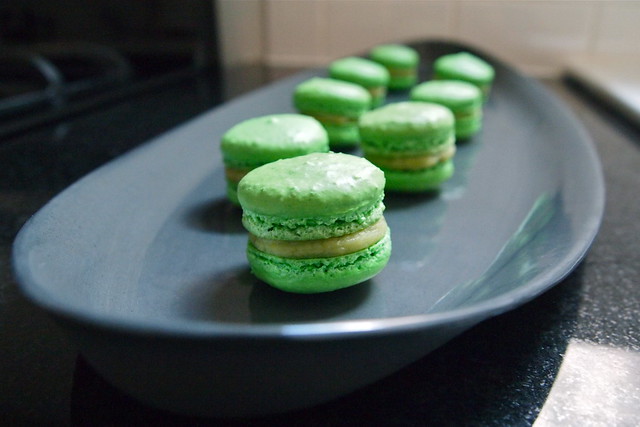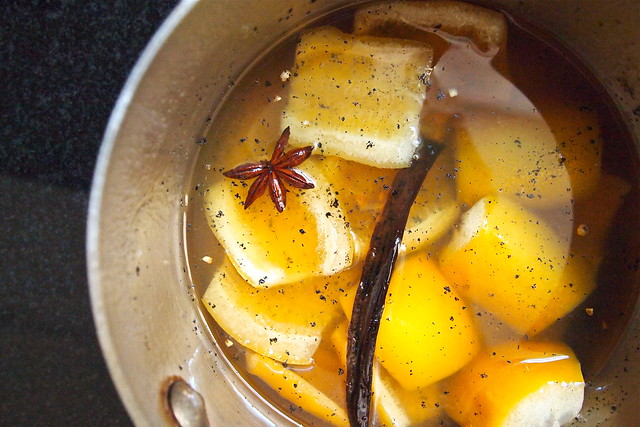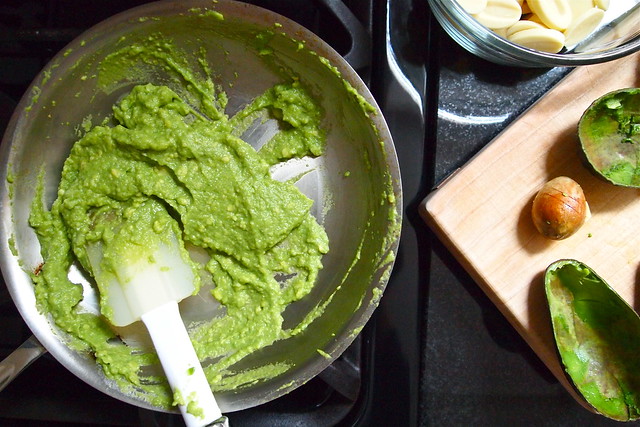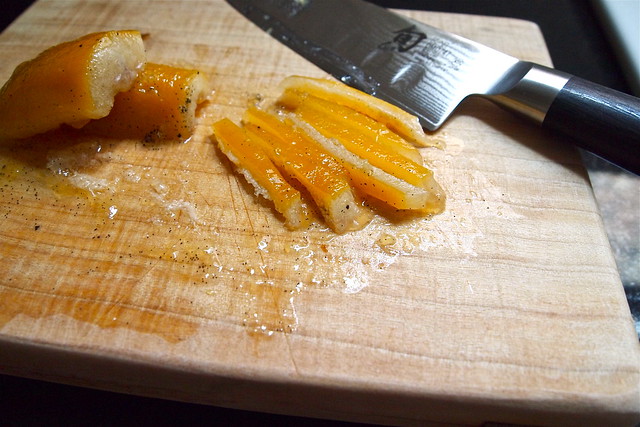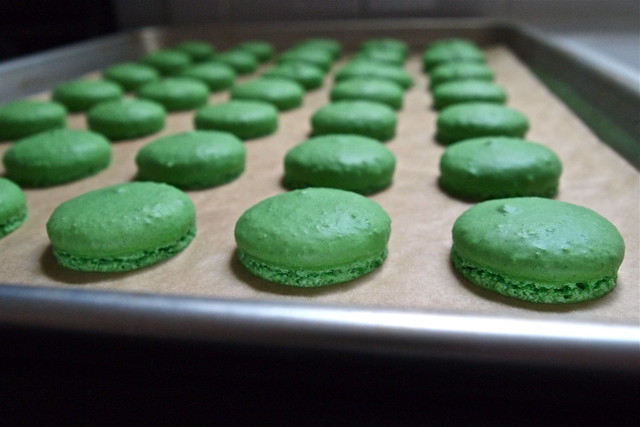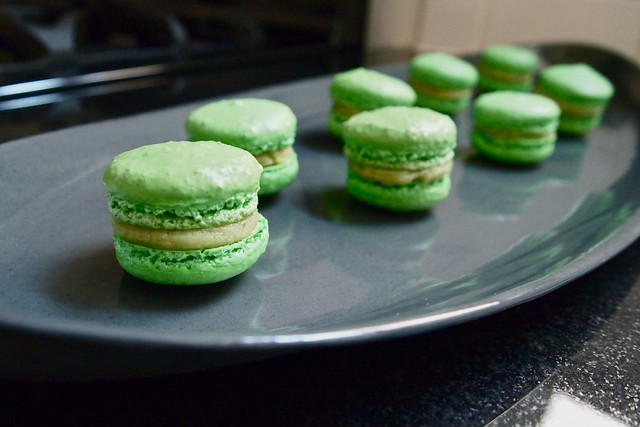Around here, breakfast tends to get the least of our attention. More often than not, it's a rushed affair. What matters is that the steady drip, drip, drip of coffee gets underway and that one of us coaxes Morning Edition from the crackle of the radio (we always seem to be losing our signal). Even on weekends, we don't linger long in the kitchen at breakfast time. I, anyway, feel most pressed in those early hours to tackle something and not let the day slip away. I have patience, enormous patience, for the sometimes slow-going, often messy stretches of making a good meal--just not at breakfast time. I get fidgety, almost anxious, for instance, hovering over the stove, flipping pancakes. It feels like an eternity passes between cracking the eggs and getting to the bottom of that big bowl of batter. So, around here, we stick mostly to buttered toast and the occasional bowl of oatmeal.
But, there are, of course, mornings on which I feel that something a little more special is in order. And lately, that hasn't at all been a problem. I've had a stash of honey-cinnamon scones in the freezer to dig into.
These are not your run-of-the-mill scone. Their texture is a bit surprising, not quite like what you might expect. There's a pleasing heft and crumbliness to them, which is delicate, melting, even. And then there's the cinnamon-honey butter that marbles the scones. The bits that find their way to the edges give those bites a special crackle and sweetness. And, rather conveniently, these scones are meant to be baked straight from the freezer. On pretty well any morning, you can probably manage to get these to the table and do whatever else you need to in order start your day. For the scones, all you have to do is get the oven ready, and they will take care of themselves. I like breakfasts that take care of themselves.
These scones come from Bouchon Bakery Cookbook. I've only had it for a couple of weeks, but I think that it's set to become my new favourite baking book. It is beautiful and staggeringly comprehensive. There is a whole section dedicated to pâte à choux. There are not one but two madeleine recipes. And, most exciting of all, there is a method for generating steam in home ovens (always a problem for bread baked at home) that calls for river rocks, chains, and a Super Soaker. The book, in this way, while certainly detail-oriented and technique-driven, doesn't take itself too, too seriously. Its tone, also, is patient and reassuring. There are lots of explanations and technical advice scattered throughout the book, but none of it feels overwhelming. I, anyway, am ready to fill a hotel pan up with rocks and chains and bake some bread soon.
Cinnamon Honey Scones
Adapted, just a little, from Thomas Keller and Sebastian Rouxel's The Bouchon Bakery Cookbook
Note: The measurements. As Keller explains, the measurements are a bit crazy-looking but only because the recipe has been scaled down for home use. The glaze. Though the scones are better with the glaze brushed on top, I have skipped it when not inclined to add another pan to my pile of dishes.
CINNAMON-HONEY CUBES
30 g / 3 tablespoons all-purpose flour
30 g / 2 1/2 tablespoons granulated sugar
4 g / 1 1/2 teaspoons ground cinnamon
30 g / 1 ounce cold unsalted butter, cut into 1/4-inch cubes
20 g / 1 tablespoon clover honey
SCONE DOUGH
152 g / 1 cup + 1 1/2 tablespoons all-purpose flour
304 g / 2 1/4 cups + 2 tablespoons cake flour
12.5 g / 2 1/2 teaspoons baking powder
2.5 g / 1/2 teaspoon baking soda
91 g / 1/4 cup + 3 1/2 tablespoons granulated sugar
227 g / 8 ounces cold unsalted butter, cut into 1/4-inch pieces
135 g / 1/2 cup + 1 1/2 tablespoons heavy cream
135 g / 1/2 cup + 2 tablespoons crème fraîche
HONEY BUTTER GLAZE
45 g / 3 tablespoons + 2 teaspoons butter
20 g / 1 tablespoon clover honey
For the cinnamon-honey cubes. Place the four in a medium bowl. Sift in the sugar and cinnamon and whisk to combine. Toss in the butter cubes, coating them with the dry mixture. Using your fingertips, break up the butter until there are no large visible pieces. Using a spatula, mix in the honey to form a smooth paste. Press the paste into a 4-inch square on a sheet of plastic wrap. Wrap tightly and freeze until solid, about two hours or for up to 1 week.
For the scones. Place the all-purpose flour in the bowl of a stand mixer and sift in the cake flour, baking, powder, baking soda, and granulated sugar. Fit the mixer with the paddle attachment and mix on the lowest setting for about 15 seconds to combine. Stop the mixer, add the butter, and then on the lowest setting, pulse to begin incorporating the butter. Increase the speed to low and mix for about 3 minutes to break up the butter and incorporate it into the dry mixture. If any large pieces of butter remain, stop the mixer, break them up by hand, and mix just until incorporated.
With the mixer running, slowly pour in the cream. Add the crème fraîche and mix for about 30 seconds, until all of the dry ingredients are moistened and the dough comes together around the paddle. Scrape down the sides and bottom of the bowl and the paddle and pulse again to combine. Remove the bowl from the mixer.
Cut the cinnamon-honey butter paste into 1/4-inch cubes and add them to the scone dough. Mix them in by hand. They may begin to break up a bit in the dough, but that's okay. Mound the dough on your work surface and, using the heel of your hand or a pastry scraper, push it together. Place the dough between two pieces of plastic wrap and, using your hands, press it into a 7 1/2-by-10-inch block, smoothing the top. Press the sides of your hands against the sides of the dough to straighten the edges. Wrap in plastic wrap and refrigerate for a bout 2 hours, until firm.
Line a baking sheet with parchment paper. Using a chef's knife or a bicycle cutter, cut the block of dough along its length into thirds and then crosswise into quarters. Arrange the dough on the parchment-lined sheet, leaving space between them. Cover with plastic wrap and freeze until solid, at least 2 hours, but preferably overnight. The scones can be stored in the freezer for up to 1 month. (If storing them long term, be sure to wrap them well or, once frozen, transfer them to an air-tight freezer bag.)
Preheat the oven to 350 degrees F (or 325 degrees F if using a convection oven). Line a sheet pan with parchment paper. Bake for 27-30 minutes (or 20-23 minutes, if using a convection oven), until golden brown.
For the glaze. Stir the butter and honey together in a small saucepan over medium-low heat until the butter has melted and combined with the honey.
As soon as the scones come out of the oven, brush the tops with the glaze. Set the sheet pan on a cooling rack and cool completely.
The scones are best on the day they are baked, but they can be stored in a covered container for 1 day.
Makes 12 scones.




